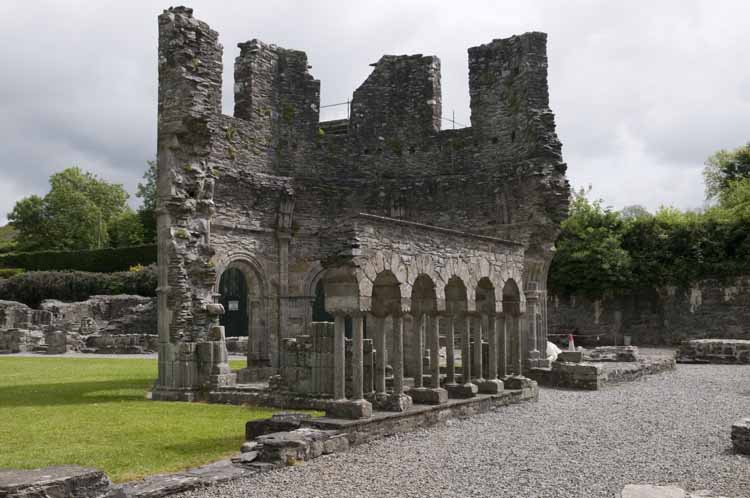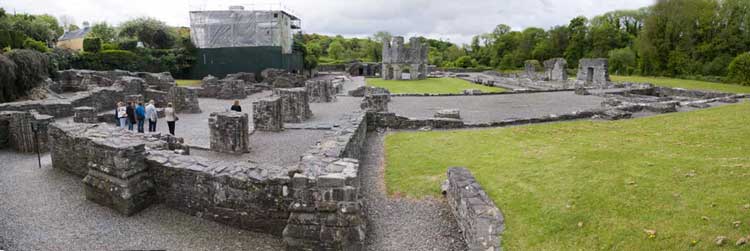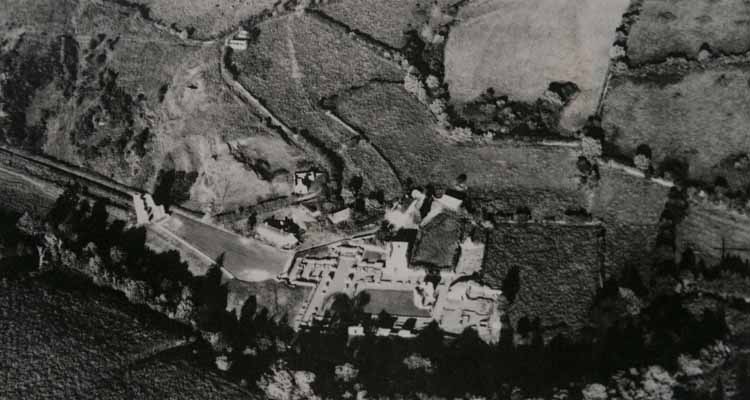
Cistercian Abbey of Mellifont, County Louth, Ireland. During 1140 Maelmhadhog O'Morgair, better known as St. Malachy the reforming bishop of Down and at one time Archbishop of Armagh, while travelling to Rome visited Clairvaux and was so impressed that on arriving at Rome he petitioned the Pope's permission to resign his bishopric and enter Clairvaux as a novice. Permission was refused but he left some of his companions at Clairvaux to be trained in the Cistercian life with a view to founding a monastery of the Order in Ireland. He chose a site for five miles north of Drogheda in County Louth - in the territory of Donnachadh Ua Cearbhaill, king of Airghialla who donated not only the land but also the materials for the building of the new abbey. The first group of monks, Irishmen trained by St. Bernard at Clairvaux, accompanied by some French monks who were to direct the building of the new abbey, arrived in 1142. Initial difficulties arising from the French design of the abbey, which interrupted the work, were settled by St. Bernard and St. Malachy and the construction was resumed and continued until completion in 1157.
Within 11 years of its foundation Mellifont had founded a number of daughter houses; Bective (1146), Boyle (1148), Monasterenanagh (1148), Baltinglass (1148), Shrule (1150) and Newry (1153). These abbeys, in their turn, sent out new foundations which brought the total number of monasteries tracing their filiation through Mellifont to 28. Within 30 years of the founding of Mellifont an army landed on the Wexford coast in 1169. The Norman invasion of Ireland had begun. The Normans were not opposed to Cistercian monastic life and as they advanced they confirmed the existing abbeys in their titles to their properties. They, themselves, founded new Cistercian abbeys, bringing communities from England and Wales to occupy them. As time passed, however, they sought to use the monasteries as centres of Norman influence by having Norman monks appointed to all positions of authority in them and, in some cases, expelling Irish monks and replacing them by men brought in from foreign monasteries. It is impossible to form an accurate judgement on the situation in the Irish monasteries as all available records are from Norman sources and we do not have balancing records from the native Irish viewpoint. Norman influence at the General Chapter of the Order reached a climax in 1227 when it deprived Mellifont of its jurisdiction over its filiations and transferred it to abbeys in England and Wales. Only gradually did the General Chapter become aware of the true situation. In 1274 it condemned the laws being enforced under Norman control, forbidding the reception of native Irish novices or the appointment of Irish monks to any position of authority in their communities. Finally it reversed its earlier decision and returned to Mellifont its jurisdiction over its filiations. The following thirty years brought a succession of Irish abbots to Mellifont and a return to its recognition by the General Chapter as the leading abbey of the Order in Ireland. By the end of the 14th century Mellifont had become a recognised Anglo Norman institution. As such, it was treated with favour by the reigning English monarch who conferred on it many civil privileges and further large tracts of land. At the beginning of the 15th century, Mellifont Abbey had become the proprietor of estates totalling 48,000 acres. The abbot had become a great feudal lord exercising civil, as well as, ecclesiastical jurisdiction in his domains and having a seat in the English House of Lords. As a totally English establishment, Mellifont had naturally lost all contact with and control over its filiations in Irish ruled territories. Over time the number of its monks diminished and Cisterci gradually disappeared altogether and Mellifont's community had become landlords, living on the revenues of their huge estates and from the parishes, churches and chapels under their jurisdiction.
After the suppression of Mellifont Abbey in 1539 by King Henry VIII, the abbey and its lands came into the hands, successively, of the Townley, Brabazon, and Moore families. Sir Garrett Moore, who lived at the abbey in 1603, was a close friend of Hugh O'Neill, and it was to Mellifont that Hugh O'Neill came to make his submission to the Lord Deputy Mountjoy at the end of the Nine Years War. He returned to Mellifont to bid farewell to his friend before setting out on his last voyage, which was to become known in history as the "Flight of the Earls". Garrett Moore, Viscount of Drogheda, died in 1628. His son Charles succeeded him but was killed in an engagement with Owen Roe O'Neill in 1643. Henry Moore, his successor, entertained the officers of King William at Mellifont on the night before the battle of the Boyne. In 1927 the fifth Earl of Drogheda sold Mellifont Abbey and its surrounding lands to Mr. Balfour of Townley Hall, and he himself settled permanently at the monastery of Monasterevan, which the Moore family had acquired through marriage, renaming it "Moore Abbey". Two years later he sold another parcel of the estate, including the greater part of the townland of Collon. This eventually passed into the hands of the Foster family, an English family who had settled at Dunleer. The village and its surroundings which had prospered as part of the estates of Mellifont Abbey before its suppression, had, at this period, become derelict and very sparsely inhabited. Anthony Foster set about remedying this situation by bringing in fifty French and English Protestant families, and investing huge sums of money in land improvements. His son John, born in 1740, married in 1764. His wife became Baroness Oriel, and later Viscountess Ferrard in 1797. John was appointed Chancellor of the Exchequer in 1785 and Speaker of the House of Commons from 1785 until the abolition of the Irish Parliament by the Act of Union in 1800. He was the strongest opponent of the Act of Union and in 1826 equally strongly opposed Catholic Emancipation. He died aged 88 in 1828. In l810, John's second son married Harriet Skeffington, assuming the Skeffington name, in order to inherit the Skeffington estates in County Antrim. In 1911 Viscount Masserene moved to Antrim Castle, leasing Oriel Demesne to a Mrs. Daly. It was later purchased by James Lyons, who sold the growing timber on the demesne to a sawmiller David Rea. The demesne and residence was eventually sold to Thomas Alexander Rudd who fought, and won, a protracted law case with Rea. When Mr. Rudd died in 1936 the estate passed into the hands of the Land Commission and in 1938 was purchased by the Cistercian community of Mount Mellery.
The site has been excavated, to some degree, and although the remains are fragmentary they do suggest the level of influence that the Cistercian building had on Ireland and also the level of influence Europe had on it. The church had a number of chapels and, unusually, they are semicircular or apsidal; this suggests a strong European influence as do the square pillars. Also, at the west end of the Nave, was a crypt which had windows indicating a somewhat regular use (rather than storage or as secure storage).
Plan of the area surrounding the Abbey and the layout of the abbey complex (de Paor et al):
Sources:
http://armagharchdiocese.org/component/content/article/15
(accessed 17-Mar-2012)
de Paor, L, Hunt, J., Plenderleith, H. J. and Dolley, M. 1969. Excavations at Mellifont Abbey, Co. Louth,
Proceedings of the Royal Irish Academy, Vol. 68, 109-164
Stalley, R. 1996. Decorating the Lavabo: Late Romanesque Sculpture from
Mellifont Abbey, Proceedings of the Royal Irish Academy, Vol.
96C, No. 7, 237-264



